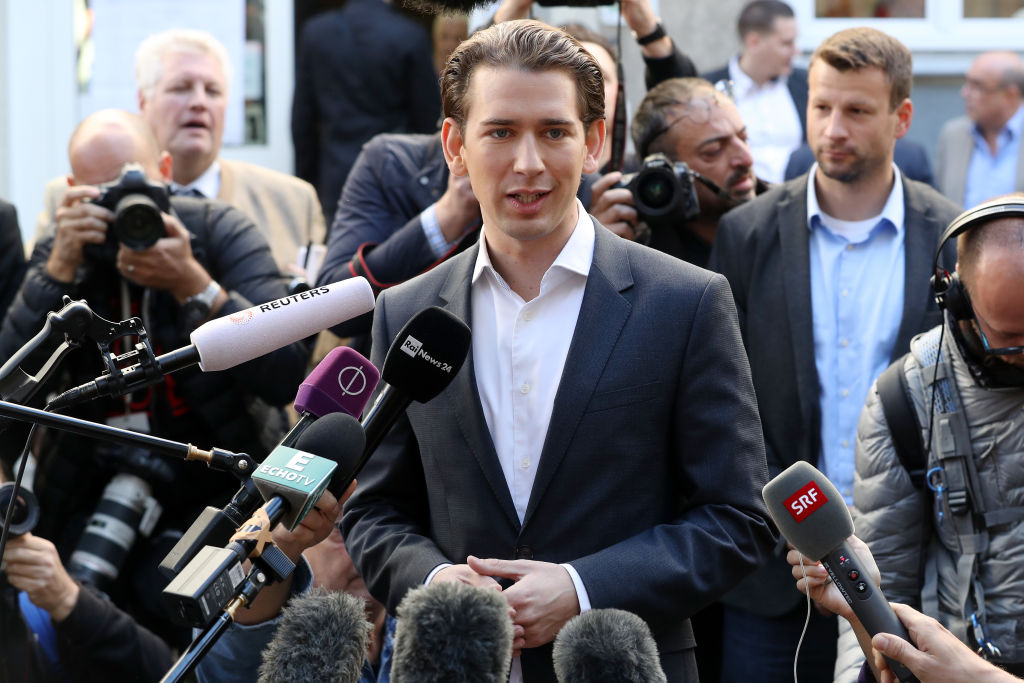Eat your heart out, Kim Jong-un. As of today, the tubby North Korean tyrant is no longer the most youthful leader on the planet. Sebastian Kurz, fresh-faced champion of the Austrian People’s Party, has won 31 per cent of votes in yesterday’s national election, making him the leader of Austria’s largest party, and the country’s next chancellor. So how did this wunderkind become the youngest national leader in Europe – and the world?
On the face of it, for the Austrian People’s Party to win an election is no surprise. The People’s Party have ruled Austria for all but 16 years since the war, almost always in some sort of coalition – and with a share of votes (and seats) well short of an absolute majority, it looks like they’ll have to form another coalition this time. What’s different is the way that Kurz has changed his party, shifting it resolutely further right.
The People’s Party has always been ostensibly centre-right, but since 2007 it’s governed Austria in a coalition with the Social Democrats. More often than not, this has been the mode of government in Austria ever since the Second World War. These ‘grand coalitions’ have provided stability, but they’ve also led to inertia. As in Germany, Austria’s two big centrist parties have become increasingly indistinguishable, forming successive coalitions and sharing the top jobs between them. It’s like a Teutonic version of that old anarchist joke: whoever you vote for, the government always wins.
This cosy consensus has opened up a big gap on the right wing of Austrian politics, and the main beneficiary has been the hard-right Austrian Freedom Party. The Freedom Party’s roots are much deeper than newer populist parties such as Alternative für Deutschland. They’ve been a major force in Austrian politics ever since the 1990s, and even served in government from 1999 to 2007, in a coalition with the People’s Party. If their charismatic leader, Jörg Haider, hadn’t died in a car crash in 2008, they might well have become even bigger. After a decade in opposition, the 2015 immigration crisis gave them a new lease of life. They’ve been riding high in the polls ever since. Last year, the Freedom Party’s Norbert Hofer very nearly became Austrian President, narrowly beaten by the Green Party’s Alexander Van der Bellen. Significantly, Van der Bellen’s Greens, Austria’s most pro-immigration party, were the biggest losers in this election. Their vote fell by 8.5 per cent to 3.9 per cent, below the 4 per cent threshold required for representation in the national parliament.
Immigration has become a burning issue in Austria – even bigger, in some respects, than in Germany. With a land border with the Balkans, Austria was the gateway into Germany for Angela Merkel’s million migrants, and Austria ended up absorbing a higher ratio (per head of population) than the Bundesrepublik. Kurz has moved away from the People’s Party’s more moderate attitudes – promising tougher policies on immigration and integration.
Needless to say, this hasn’t made him popular with Austria’s other parties. Social Democrats have accused him of stealing the Freedom Party’s clothes. Even the Freedom Party aren’t happy. Their leader, Heinz-Christian Stracher, called him ‘an imposter.’ However as an electoral strategy, Kurz’s anti-immigration stance has been inspired. Even running against Kurz, the Freedom Party have polled some 27 per cent of the votes, their highest ever haul. If the People’s Party had fielded a blander, safer candidate, the Freedom Party could quite possibly have won this election outright.
With some votes still uncounted, the Freedom Party and the Social Democrats are currently neck and neck, and in theory Kurz could form a coalition with either of them. Either option would be problematic. Another grand coalition with the Social Democrats would auger more of the same-old same-old – hardly the transformation Kurz promised when he rebranded the People’s Party as the ‘New People’s Party’ and changed its campaign colours from dowdy black to lurid turquoise.
A coalition with the Freedom Party would present a different set of problems. Despite the precedent of the Noughties, when the two parties governed in tandem for seven years, it would still be intensely controversial – particularly abroad. In the Noughties, this partnership was an aberration. Now, it would be a clarion call for populist parties all over Europe. Might Kurz even try to form a minority government? Austria has seen nothing like it, but then again it’s seen nothing quite like Sebastian Kurz.
For conservatives, the success of Kurz’s anti-immigrant campaign is a sign that democracy works. In Austria, as in Germany, centre-right parties moved too far towards the centre, and conservative voters drifted towards far right parties. Kurz’s rebranding of the People’s Party shows the centre-right can adapt and respond to voters’ concerns, rather than driving them into the arms of unsavoury and incompetent extremists. Across the border, in Germany, things are moving in the same direction. Merkel’s Christian Democrats have resolved to cap immigration at 200,000 per annum, in response to pressure from their conservative allies, the Bavarian CSU.
For the Conservative Party in the 1970s, one of the main attractions of Europe was that Europe’s moderate centrism was a welcome contrast to the socialist agitation and chaos in Britain at that time. As Europe rediscovers centre-right politics, in France and Germany, and now in Austria, and Comrade Corbyn’s revolution gathers pace, might British conservatives find themselves in the same position again?






Comments